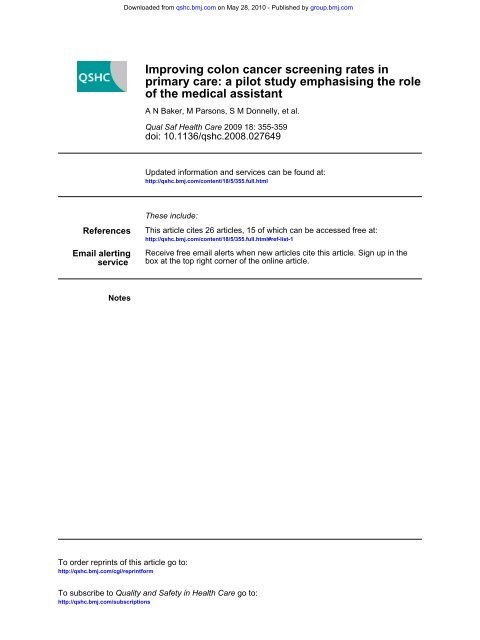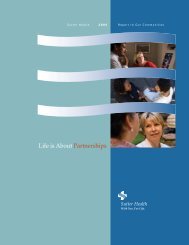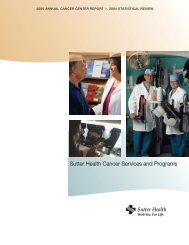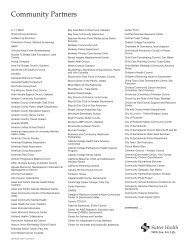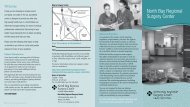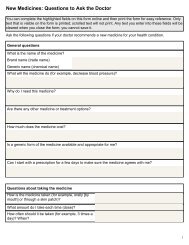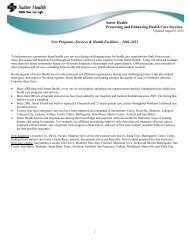Improving Colon Cancer Screening Rates In Primary ... - Sutter Health
Improving Colon Cancer Screening Rates In Primary ... - Sutter Health
Improving Colon Cancer Screening Rates In Primary ... - Sutter Health
You also want an ePaper? Increase the reach of your titles
YUMPU automatically turns print PDFs into web optimized ePapers that Google loves.
Downloaded from qshc.bmj.com on May 28, 2010 - Published by group.bmj.com<br />
<strong>Improving</strong> colon cancer screening rates in<br />
primary care: a pilot study emphasising the role<br />
of the medical assistant<br />
A N Baker, M Parsons, S M Donnelly, et al.<br />
Qual Saf <strong>Health</strong> Care 2009 18: 355-359<br />
doi: 10.1136/qshc.2008.027649<br />
Updated information and services can be found at:<br />
http://qshc.bmj.com/content/18/5/355.full.html<br />
References<br />
Email alerting<br />
service<br />
These include:<br />
This article cites 26 articles, 15 of which can be accessed free at:<br />
http://qshc.bmj.com/content/18/5/355.full.html#ref-list-1<br />
Receive free email alerts when new articles cite this article. Sign up in the<br />
box at the top right corner of the online article.<br />
Notes<br />
To order reprints of this article go to:<br />
http://qshc.bmj.com/cgi/reprintform<br />
To subscribe to Quality and Safety in <strong>Health</strong> Care go to:<br />
http://qshc.bmj.com/subscriptions
Downloaded from qshc.bmj.com on May 28, 2010 - Published by group.bmj.com<br />
Original research<br />
<strong>Improving</strong> colon cancer screening rates in primary<br />
care: a pilot study emphasising the role of the<br />
medical assistant<br />
A N Baker, 1 M Parsons, 2 S M Donnelly, 1 L Johnson, 1 J Day, 2 A Mervis, 2 B James, 3<br />
R Burt, 4 M K Magill 2<br />
1 <strong>Health</strong><strong>In</strong>sight, Salt Lake City,<br />
Utah, USA; 2 University of Utah,<br />
Community Clinics, Salt Lake<br />
City, Utah, USA; 3 <strong>In</strong>termountain<br />
<strong>Health</strong> Care, Salt Lake City,<br />
Utah, USA; 4 University of Utah,<br />
Huntsman <strong>Cancer</strong> <strong>In</strong>stitute, Salt<br />
Lake City, Utah, USA<br />
Correspondence to:<br />
Dr M K Magill, Department of<br />
Family and Preventive Medicine,<br />
School of Medicine, University of<br />
Utah, 375 Chipeta Way, Suite A,<br />
Salt Lake City, UT 84108, USA;<br />
michael.magill@hsc.utah.edu<br />
Accepted 7 July 2008<br />
ABSTRACT<br />
Background: Colorectal cancer (CRC) is the third-leading<br />
cause of cancer death for both men and women in the<br />
USA. Despite consensus recommendations for screening,<br />
just over half of eligible adults nationally have undergone<br />
screening. We therefore implemented a programme to<br />
improve the rate of CRC screening.<br />
Methods: This study was conducted in the Utah <strong>Health</strong><br />
Research Network and the University of Utah Community<br />
Clinics, a 100 000 patient, seven-practice, universityowned<br />
system offering primary and secondary care and<br />
ancillary services including endoscopy. We focused on<br />
patients aged >50 who were seen between 1 January<br />
2003 and 31 October 2006, and who were not current for<br />
CRC screening at the time of the visit. The study included<br />
a three-phase intervention: electronic medical record<br />
(EMR) reminders, physician and medical assistant (MA)<br />
education about CRC screening guidelines, and redesign<br />
of patient visit workflow with an expanded role for MAs to<br />
review patients’ CRC screening status and recommend<br />
testing when appropriate. With patient agreement, the<br />
MA entered a preliminary order in the EMR, and the<br />
physician confirmed or rejected the order. The primary<br />
outcome measure was the rate of screening colonoscopy<br />
ordered for eligible patients.<br />
Results: The baseline colonoscopy referral rate was<br />
6.0%. Provider education and electronic reminders had<br />
minimal immediate impact on screening rates. Addition of<br />
the expanded MA role was associated with a sustained<br />
increase in colonoscopy referral order rate to 13.4%, a<br />
relative improvement of 123%.<br />
Conclusions: The MA can play a key role in improving<br />
CRC screening rates as part of a redesigned system of<br />
primary care.<br />
Colorectal carcinoma (CRC), cancers of the colon<br />
and rectum combined, are the third most common<br />
cause of new cancer cases and deaths in the USA<br />
for both men and women. 1 An individual’s lifetime<br />
risk of developing CRC in the USA is nearly 6%,<br />
with over 90% of cases occurring after age 50. 2<br />
<strong>Screening</strong><br />
<strong>Screening</strong> can decrease CRC mortality by enabling<br />
detection and removal of precancerous polyps and<br />
early cancers before they undergo malignant<br />
transformation or metastasise. 3 If screening were<br />
universally applied, up to 90% of all CRC cases and<br />
deaths would be preventable. 4 5 Consensus evidence-based<br />
recommendations call for screening of<br />
all persons beginning at age 50. High-risk individuals<br />
should begin screening at younger ages and/<br />
or more frequently than others. 2 <strong>Screening</strong> options<br />
include the use of faecal occult blood testing,<br />
flexible sigmoidoscopy, contrast barium enema and<br />
colonoscopy, alone or in combination. Although<br />
the ideal screening test and protocol are yet to be<br />
determined, the US Preventive Services Task Force<br />
ranks colonoscopy as ‘‘the most sensitive and<br />
specific test for detecting cancer and large polyps.’’ 3<br />
The use of CRC screening tests in the USA is<br />
unacceptably low. 6 7 <strong>In</strong> 2004, 57.3% of adults aged<br />
>50 years reported having been screened appropriately<br />
with either faecal occult blood testing or<br />
colonoscopy. 8<br />
Strategies to improve screening<br />
Multiple strategies are used in primary care to<br />
improve CRC screening rates including patient<br />
counselling or education, provider education, medical<br />
record-based protocols and combinations of<br />
these. 9 10 The advent of the electronic medical<br />
record (EMR) offers opportunities to provide<br />
patient-specific reminders and decision support to<br />
improve screening rates, often combining EMR<br />
functions with medical practice system changes. 10–18<br />
<strong>In</strong>creasingly, investigators are recognising that<br />
primary care practice improvement requires<br />
changes in physician and staff roles as part of<br />
effective teams, with medical assistants (MAs)<br />
serving a key role. 19<br />
Education<br />
Physician education is commonly used in an effort<br />
to increase CRC screening. However, didactic<br />
education alone is relatively ineffective at changing<br />
physician behaviour. 20 Low rates of ordering and<br />
completion of screening tests for eligible patients<br />
are likely related to multiple factors including:<br />
competing priorities during acute-care visits, management<br />
of chronic illnesses and comorbidities. 10<br />
CRC screening in particular may encounter added<br />
patient resistance due to discomfort, cost and<br />
perceived screening risks, although rates of patient<br />
refusal of recommended tests such as colonoscopy<br />
are not well known.<br />
Reminders<br />
Implementation of EMR-based reminders or<br />
prompts has been shown to improve CRC screening<br />
rates, although provider compliance with<br />
11–15 17<br />
prompts is variable. For example, an early<br />
(1996) study found that more than half of<br />
electronic reminders did not lead to recommended<br />
Qual Saf <strong>Health</strong> Care 2009;18:355–359. doi:10.1136/qshc.2008.027649 355
Downloaded from qshc.bmj.com on May 28, 2010 - Published by group.bmj.com<br />
Original research<br />
testing. 14 Reasons for non-compliance with electronic reminders<br />
include: lack of coordination between nursing staff and<br />
physicians, physician review of the prompt when the patient<br />
is absent, competing workload demands and lack of flexibility in<br />
implementation of the EMR prompt. 15<br />
Teams: the MA role<br />
<strong>Primary</strong> care is complex. Full implementation of all recommended<br />
evidence-based preventive care, acute care and chronic<br />
disease management to an average panel of primary care<br />
patients would require in excess of 18 h per day for a physician<br />
working in a traditional physician-centred practice model. 21<br />
Recognition of this reality and of the need to improve quality<br />
in primary care has led to the emergence of multiple models of<br />
team-based primary care, virtually all of which include<br />
significantly enhanced roles for non-physician team members,<br />
especially MAs. 19<br />
According to the Bureau of Labor Statistics, the medical<br />
assistant occupation is projected to be one of the fastestgrowing<br />
occupations in the 2004–2014 period. 22 Some MAs are<br />
trained on the job. Many complete 1- to 2-year programmes in<br />
high schools, postsecondary vocational schools, and community<br />
and junior colleges. 22 MAs usually work under their supervising<br />
physician’s license and are ‘‘not licensed to make independent<br />
medical assessments or give advice.’’ 23 An MA’s greatest value<br />
may be to help providers optimise office workflow, allowing<br />
providers to see more patients and accomplish more during<br />
encounters. 23 <strong>In</strong> their guide to delivering clinical preventive<br />
services, the Agency for <strong>Health</strong>care Research and Quality<br />
emphasises the need to involve all levels of staff in preventive<br />
services and spread out tasks among staff. 24 However, many<br />
physicians underassign tasks and do not allow MAs to work to<br />
their fullest potential. 23 <strong>In</strong> addition, although many medical<br />
practices are implementing enhanced MA roles, research<br />
demonstrating improved quality of care specifically linked to<br />
these enhanced roles is limited.<br />
We therefore report here results of a study designed to<br />
increase CRC screening rates. The three-phase study intervention<br />
included physician and MA education about CRC screening,<br />
advanced EMR reminder features and redesigned clinical<br />
team roles. This last phase of the intervention included<br />
expanded MA responsibility to review patients’ CRC screening<br />
status, initiate discussion of recommended tests and prepare<br />
preliminary orders for patients agreeing to colonoscopy.<br />
METHODS<br />
Setting<br />
This study was conducted in the University of Utah<br />
Community Clinics (UUCCs) and its research arm, the Utah<br />
<strong>Health</strong> Research Network (a practice-based research network<br />
(PBRN)). At the time of this study, the UUCCs were a 100 000-<br />
patient, seven-practice, multispecialty, primary care network<br />
with sites in and around the Salt Lake valley and linked by an<br />
electronic medical record, EpicCareß (Epic).<br />
<strong>In</strong>tervention<br />
Phase I: EMR prompt for CRC screening<br />
The UUCCs began using Epic on 1 July 2001. On 15 March<br />
2002, a computerised reminder suggesting colonoscopy—for all<br />
patients 50 years or older without previously documented<br />
colonoscopies—was added to the system. Prior to initiating<br />
the EMR prompt for the present study, we developed a detailed<br />
flow chart to describe how this reminder was used in practice to<br />
identify and refer patients due for CRC screening. Direct<br />
observations of 30 clinical visits for patients 50 years or older in<br />
three of the UUCCs revealed that physicians were systematically<br />
bypassing and ignoring the EMR reminder. The prompt<br />
appeared at an inopportune time early in the doctor–patient<br />
encounter, when patients and physicians were focused on the<br />
patient’s reason for the visit, and did not readily lead to action<br />
by the clinician. As the first intervention for the present study, a<br />
refined prompt was implemented in October 2004.<br />
Phase II: physician and MA education<br />
Beginning in December 2004, we conducted physician education<br />
sessions for all UUCC primary care physicians who cared for<br />
adults (family medicine, internal medicine and obstetrics/<br />
gynecology). We also identified physician and MA opinion<br />
leaders. These leaders attended additional education sessions,<br />
contributed to clinic workflow redesign and served as liaisons<br />
for our study, providing feedback to peers and encouraging<br />
them to make CRC screening a priority.<br />
Phase III: redesigned clinical workflow<br />
Beginning in February 2005, we worked with physician opinion<br />
leaders to alter clinical workflow, assigning MAs the responsibility<br />
to initiate discussion of CRC screening with the patient<br />
before being seen by the physician, as the MA was completing<br />
preliminary patient evaluation. This change took advantage of<br />
the fact the EMR prompt appeared early in the encounter<br />
sequence, and separated this discussion from the physician’s<br />
assessment of the primary reason(s) for the visit. We provided a<br />
script—written by one of the clinic doctors who was also a<br />
member of our research team—for MAs to use when the<br />
electronic prompt indicated the patient was due for CRC<br />
screening (see table 1). If the patient requested colonoscopy, the<br />
MA placed a preliminary order for scheduling the test in the<br />
medical record. This served as a convenient prompt to<br />
physician–patient discussion of screening at an appropriate<br />
point in the visit, after assessment of the patient’s reason(s) for<br />
the visit. Physicians then chose to order or not order the test as a<br />
routine and efficient part of the visit workflow.<br />
For a limited period of time after initiation of the new<br />
workflow, and as a way to help all involved develop the habit of<br />
following the new process, MAs were asked to keep a daily log<br />
of patients over the age of 50. The logs were meant to document<br />
compliance with the process and serve as an additional reminder<br />
to ask patients about screening (see table 2). Completed logs<br />
were submitted weekly from February through May 2005. We<br />
published cumulative results of these logs in a newsletter sent to<br />
the MA–physician teams. We presented small rewards to teams<br />
of MAs and physicians with the highest CRC screening rates.<br />
Data analysis<br />
<strong>Colon</strong>oscopy referral rates were calculated using data from the<br />
UUCC Epic clinical data warehouse. Referral rates were<br />
calculated for each month, beginning 1 January 2003, through<br />
31 October 2006. Patients were included in the study population<br />
for a given month if: (1) they had an encounter with a primary<br />
care physician in one of the seven clinics as identified by current<br />
procedural terminology (CPT) code, and (2) they were age<br />
50 years or older at the time of the encounter. Patients were<br />
excluded if they had a documented history of colectomy or<br />
comorbidities that contraindicated colonoscopy.<br />
Patients were classified as up to date on referral for<br />
colonoscopy if they had: (1) evidence of a colonoscopy<br />
356 Qual Saf <strong>Health</strong> Care 2009;18:355–359. doi:10.1136/qshc.2008.027649
Downloaded from qshc.bmj.com on May 28, 2010 - Published by group.bmj.com<br />
Original research<br />
Table 1<br />
Medical assistant screening script<br />
I notice that you may be due for colon cancer screening. Have you had a colonoscopy?<br />
‘‘Yes’’<br />
Let me see if I have a copy of that report<br />
If you have a copy of that report, update health maintenance tab or make a note of date on progress note<br />
If you do not have a copy, ask when/where it was done and give patient a record release to send for report<br />
‘‘No’’<br />
The American <strong>Cancer</strong> Society recommends colon cancer screening for everyone over age 50. Have you thought about having a<br />
colonoscopy?<br />
Enter preliminary order for physician review and decision or give patient information, depending on their response<br />
If patient has had a flexible sigmoidoscopy or completed stool cards, make a note<br />
completed within 10 years prior to the indexed encounter, (2)<br />
evidence in the health maintenance section of their Epic record<br />
of refusal of colonoscopy within a 12-month period preceding<br />
the encounter date or (3) evidence of referral for colonoscopy in<br />
the 6-month period preceding the encounter date. The remaining<br />
patients were considered not to be current for CRC<br />
screening and therefore eligible for a CRC screening referral.<br />
We used an X moving Range (XmR) chart to follow<br />
colonoscopy referral rates over time, and interrupted time series<br />
methods to determine if the intervention impacted those rates. 25<br />
For the baseline period of January 2003 through September<br />
2004, the mean monthly referral rate and its upper and lower<br />
control limits were calculated from the median absolute value of<br />
the range of differences between successive monthly values,<br />
scaled by a factor of 3.27. The control limits define the<br />
boundaries of random, month-to-month variation in referral<br />
rates in the absence of external influences or other special<br />
causes. The baseline control limits and mean monthly referral<br />
rate are projected through the postintervention period of<br />
October 2004 through September 2005. To determine if<br />
postintervention referral rates are consistently elevated above<br />
the baseline we used a simple run test, with the baseline mean<br />
as the threshold, to test for non-randomness in the postintervention<br />
referral rates. 26<br />
RESULTS<br />
During the study period, 23 651 patients 50 years of age or older<br />
were seen by primary care physicians in the UUCCs. Of these,<br />
169 were identified as having had colectomies or comorbidities<br />
that precluded colonoscopy. The remaining 23 482 patients<br />
generated a total of 152 271 encounters. There were 77 849<br />
encounters, representing 18 702 unique patients, where the<br />
patient was determined to be eligible for CRC screening. The<br />
mean number of such encounters per month was 1692 (range:<br />
1235 to 2232).<br />
Figure 1 shows the rate of colonoscopy referrals by month.<br />
Baseline rates for colonoscopy referrals for unscreened patients<br />
in the UUCCs were stable, with a mean monthly referral rate of<br />
6.0% (range: 4.9 to 7.4%). For the postintervention period, the<br />
mean rate was 11.1% (range: 5.6 to 15.9%); an absolute<br />
improvement of 5.1% and a relative improvement of 85%.<br />
Three major interventions are shown in fig 1 to illustrate the<br />
temporal relationship between the interventions and the<br />
Table 2 Manual colon cancer screening log<br />
Review activity<br />
colonoscopy referral rates. First, an upgrade to the EMR that<br />
changed the display of the CRC screening reminder was<br />
installed beginning 12 October 2004. This upgrade appeared to<br />
have no immediate effect on CRC screening referral rates.<br />
Second, physician education was completed in December 2004.<br />
This was followed the next month by an increase in referral<br />
rates to 7.5%. Third, in February 2005, MAs were educated<br />
about CRC screening, instructed to initiate discussions of CRC<br />
screening (see table 1), and use the logs to report the discussions<br />
(see table 2). This third intervention was followed by a large and<br />
sustained increase in colonoscopy referral rates. Following this<br />
intervention, the mean monthly referral rate increased to 13.4%,<br />
a relative improvement of 123%, and all values exceeded the<br />
baseline upper control limit of 7.3%. The probability of<br />
observing such a run of points by random chance is extremely<br />
small (p,0.01).<br />
DISCUSSION<br />
This study demonstrated a statistically significant and clinically<br />
meaningful increase in rates of referral for screening colonoscopy<br />
in a group of primary care practices. Improvement did not<br />
appear to be temporally related to changes in the computerised<br />
reminder system. A modest referral rate increase was seen<br />
shortly after physician education, but a large increase was seen<br />
after instituting an expanded role for MAs using the reminder as<br />
a prompt to review CRC screening status with patients and<br />
encourage referral for colonoscopy. We believe this system,<br />
especially the enhanced MA role, was responsible for increased<br />
rates of colonoscopies ordered in accord with recommended<br />
CRC screening guidelines.<br />
<strong>Primary</strong> care visits have multiple competing priorities including<br />
acute care, chronic disease management, attention to<br />
psychosocial needs and prevention. The latter includes multisystem<br />
cancer and metabolic screenings, patient education and<br />
immunisations. Many patients have multiple comorbidities that<br />
limit attention to preventive interventions such as CRC<br />
screening. 27 Even during visits scheduled specifically for preventive<br />
care, providers frequently address multiple problems. <strong>In</strong><br />
addition, although prevalence of neoplasia increases with age,<br />
screening colonoscopy in very elderly persons (age.80 years)<br />
results in only 15% of the expected gain in life expectancy in<br />
younger patients. 28 Guideline-based recommendations may need<br />
adjustment for individual patient circumstances.<br />
Order activity<br />
No pop-up<br />
(no screening<br />
needed)<br />
Had colonoscopy<br />
(records in EpicCareß,<br />
but need to update<br />
<strong>Health</strong> Maintenance<br />
section of the record)<br />
Had<br />
colonoscopy<br />
(no records in<br />
EpicCareß)<br />
Sent<br />
release<br />
Due for<br />
colonoscopy<br />
(patient<br />
refused)<br />
No documentation<br />
(forgot to ask)<br />
Ordered<br />
colonoscopy<br />
Ordered flexible<br />
sigmoidoscopy<br />
Ordered<br />
faecal<br />
occult<br />
blood test<br />
Other<br />
Qual Saf <strong>Health</strong> Care 2009;18:355–359. doi:10.1136/qshc.2008.027649 357
Downloaded from qshc.bmj.com on May 28, 2010 - Published by group.bmj.com<br />
Original research<br />
Figure 1<br />
<strong>Colon</strong>oscopy referrals for patients not current at encounter. EMR, electronic medical record; MA, medical assistant.<br />
The advent of EMRs offers a unique opportunity to improve<br />
preventive healthcare. However, the ability of computerised<br />
reminders to affect physician behaviour is limited. 29 This study<br />
reaffirms that electronic prompts alone do not markedly<br />
improve rates of referral for CRC screening. It also confirms<br />
that provider education, a much-used method for improving<br />
clinical outcomes, has, at best, a limited effect on referral rates.<br />
This study is consistent with Bodenheimer’s observation that<br />
MAs ‘‘often play the key role of managing the flow of activity in<br />
primary care’’ and can ‘‘become the engine of improvement in<br />
primary care.’’ 19 MAs and other non-physician office staff<br />
reliably facilitate preventive and chronic care. 30–32 MA phone<br />
calls to patients proved a reliable and cost-effective way to<br />
encourage mammography adherence. 33 O’Brien et al found that<br />
clinical support staff are effective in routinely asking patients<br />
with diabetes to remove their shoes before seeing the provider as<br />
a way to increase the likelihood the physician will complete a<br />
foot examination (although these authors attributed the<br />
increase in foot exams to physician education more than to<br />
change in support staff roles). 31 A clinical trial funded by the<br />
Robert Wood Johnson Foundation is under way to determine<br />
whether a screening and intervention programme carried out by<br />
MAs in primary care practices can help patients improve health<br />
behaviours. 34<br />
Our results are also consistent with the findings of Kirkman et<br />
al, regarding common elements of successful clinical quality<br />
improvement (QI) interventions in outpatient practices. These<br />
elements include four factors: (1) the QI efforts ‘‘occur in<br />
‘closed’ systems with standard processes for scheduling,<br />
recordkeeping, and carrying out orders;’’ (2) ‘‘… physicians are<br />
influenced by mandates or incentive for improvement;’’ (3)<br />
routine aspects of care are removed from the physician, making<br />
nurses or others (e.g., MAs) responsible for these behaviours; (4)<br />
information systems are used to track data, identify high-risk<br />
patients, provide screening prompts, generate orders and track<br />
results. 30 Workflow redesign helps overcome the barriers to<br />
consistently translating knowledge and intent into practice. 16 <strong>In</strong><br />
accord with others, we found that medical assistants armed<br />
with an electronic reminder more consistently facilitated orders<br />
about CRC screening than did physicians acting independently.<br />
31 32<br />
Limitations<br />
Our results may have underestimated the true rate of<br />
colonoscopy referral or, more broadly, CRC screening. This is<br />
because we only queried specific fields in our EMR for presence<br />
of colonoscopy results. We did not review free text progress<br />
notes, and we did not assess performance of other acceptable<br />
forms of CRC screening. Such documentation would be<br />
necessary to more accurately assess MA and physician response<br />
to the interventions and to identify the true rate of completed<br />
screening.<br />
Thus, this study may not provide an accurate estimate of<br />
‘‘true’’ CRC screening rates in our population. However, our<br />
focus in this study was on change in rates of colonoscopy<br />
referral for CRC screening, and we believe the methodology was<br />
equally accurate before and after our intervention, thus a valid<br />
indicator of relative change in referral rates.<br />
Providers tend to overestimate the number of patients they<br />
recommend for CRC screening. 10 Nonetheless, the acknowledged<br />
limitations of these data sources contributed to some<br />
provider skepticism about the data and may have reduced their<br />
motivation to participate in this project.<br />
Because the three phases of our intervention (provider<br />
education, alteration of EMR reminder and clinical workflow<br />
redesign) occurred in rapid sequence, it is impossible to isolate<br />
the effects of any one phase. While we identified the greatest<br />
increase in CRC screening rates after the third phase, clinical<br />
workflow redesign, attributing the increase exclusively to the<br />
expanded MA role could underestimate delayed or interacting<br />
effects of provider education and EMR reminder alterations.<br />
Our research team is unusual in its ability to implement<br />
change like this because we are a university-owned and operated<br />
practice group. This contrasts with most PBRNs, which rely on<br />
more arm’s-length relationships. The unified management and<br />
EMR implementation across all practices in this project may<br />
have increased compliance compared with studies in other<br />
settings.<br />
CONCLUSION<br />
Electronic decision support tools alone do not increase CRC<br />
screening referral rates. Facilitators, IT support staff and system<br />
changes were all necessary to effect change. The greatest barrier<br />
to CRC screening for providers seemed to be competing<br />
demands during a short patient visit. Adding redesigned clinical<br />
workflow, particularly an expanded role for the MA, appeared<br />
to increase referrals for CRC screening. These results are<br />
consistent with the literature on prevention and chronic<br />
13 30–32<br />
care, suggesting that this approach may be useful to<br />
enhance other disease-prevention and health-promotion<br />
358 Qual Saf <strong>Health</strong> Care 2009;18:355–359. doi:10.1136/qshc.2008.027649
Downloaded from qshc.bmj.com on May 28, 2010 - Published by group.bmj.com<br />
Original research<br />
interventions. Further work will be necessary to assess the<br />
relative impacts of individual components of such multifactorial<br />
system changes.<br />
Acknowledgements: The authors acknowledge R Lloyd and D Palmer, University of<br />
Utah Community Clinics, for their expertise in clinical practice redesign that included an<br />
expanded role for medical assistants. The authors thank J Nunu, for editorial<br />
assistance.<br />
Funding: This research was supported, in part, by grant number 1 R21 CA107216-<br />
01A1 from the National <strong>Cancer</strong> <strong>In</strong>stitute.<br />
Competing interests: None.<br />
REFERENCES<br />
1. Anon. Colorectal (colon) cancer. Basic information. http://www.cdc.gov/cancer/<br />
colorectal/basic_info/ (accessed 6 Apr 2008).<br />
2. Burt RW. <strong>Colon</strong> cancer screening. Gastroenterology 2000;119:837–53.<br />
3. US Preventive Services Task Force. <strong>Screening</strong> for colorectal cancer:<br />
Recommendation and rationale. Ann <strong>In</strong>tern Med 2002;137:129–31.<br />
4. Winawer S, Fletcher R, Rex D, et al. Colorectal cancer screening and surveillance:<br />
Clinical guidelines and rationale-update based on new evidence. Gastroenterology<br />
2003;124:544–60.<br />
5. Winawer SJ, Zauber AG, Ho MN, et al. Prevention of colorectal cancer by<br />
colonoscopic polypectomy. The national polyp study workgroup. N Engl J Med<br />
1993;329:1977–81.<br />
6. Anon. Trends in screening for colorectal cancer—United States, 1997 and 1999.<br />
Morb Mortal Wkly Rep 2001;50:162–6.<br />
7. Frazier AL, Colditz GA, Fuchs CS, et al. Cost-effectiveness of screening for colorectal<br />
cancer in the general population. JAMA 2000;284:1954–61.<br />
8. Centers for Disease Control and Prevention. <strong>In</strong>creased use of colorectal cancer<br />
tests—United States, 2002 and 2004. Morb Mortal Wkly Rep 2006;55:308–11.<br />
9. Ferreira MR, Dolan NC, Fitzgibbon ML, et al. <strong>Health</strong> care provider-directed<br />
intervention to increase colorectal cancer screening among veterans: Results of a<br />
randomized controlled trial. J Clin Oncol 2005;23:1548–54.<br />
10. Wei EK, Ryan CT, Dietrich AJ, et al. <strong>Improving</strong> colorectal cancer screening by<br />
targeting office systems in primary care practices: Disseminating research results into<br />
clinical practice. Arch <strong>In</strong>tern Med 2005;165:661–6.<br />
11. Balas EA, Weingarten S, Garb CT, et al. <strong>Improving</strong> preventive care by prompting<br />
physicians. Arch <strong>In</strong>tern Med 2000;160:301–8.<br />
12. Krall MA, Sittig DF. Clinician’s assessments of outpatient electronic medical record<br />
alert and reminder usability and usefulness requirements. Proc AMIA Symp<br />
2002:400–4.<br />
13. Litzelman DK, Dittus RS, Miller ME, et al. Requiring physicians to respond to<br />
computerized reminders improves their compliance with preventive care protocols.<br />
J Gen <strong>In</strong>tern Med 1993;8:311–17.<br />
14. Litzelman DK, Tierney WM. Physicians’ reasons for failing to comply with<br />
computerized preventive care guidelines. J Gen <strong>In</strong>tern Med 1996;11:497–9.<br />
15. Saleem JJ, Patterson ES, Militello L, et al. Exploring barriers and facilitators to the<br />
use of computerized clinical reminders. J Am Med <strong>In</strong>form Assoc 2005;12:438–47.<br />
16. Trivedi MH, Kern JK, Grannemann BD, et al. A computerized clinical decision<br />
support system as a means of implementing depression guidelines. Psychiatr Serv<br />
2004;55:879–85.<br />
17. Zheng K, Padman R, Johnson MP, et al. An adoption study of a clinical reminder<br />
system in ambulatory care using a developmental trajectory approach. Medinfo<br />
2004;11:1115–19.<br />
18. Sarfaty M, Wender R. How to increase colorectal cancer screening rates in practice.<br />
CA <strong>Cancer</strong> J Clin 2007;57:354–66.<br />
19. Bodenheimer T. Building teams in primary care: Lessons learned. Oakland: California<br />
<strong>Health</strong>Care Foundation, 2007.<br />
20. Davis D, O’Brien MA, Freemantle N, et al. Impact of formal continuing medical<br />
education: Do conferences, workshops, rounds, and other traditional continuing<br />
education activities change physician behavior or health care outcomes? JAMA<br />
1999;282:867–74.<br />
21. Yarnall KS, Pollak KI, Ostbye T, et al. <strong>Primary</strong> care: Is there enough time for<br />
prevention? Am J Public <strong>Health</strong> 2003;93:635–41.<br />
22. Bureau of Labor Statistics. Occupational outlook handbook, 2005–2006. Medical<br />
Assistants. http://www.bls.gov/oco/ocos164.htm (accessed 5 Dec 2006).<br />
23. Tache S, Chapman S. What a medical assistant can do for your practice. Fam Pract<br />
Manag 2005;12:51–4.<br />
24. Agency for <strong>Health</strong>care Research and Quality. Put prevention into practice—a<br />
step-by-step guide to deliverign clinical preventive services: a systems approach.<br />
May 2002. Available at: http://www.ahrq.gov/ppip/manual/manual.pdf (accessed 14<br />
May 2007).<br />
25. Mohammed MA, Worthington P, Woodall WH. Plotting basic control charts: Tutorial<br />
notes for healthcare practitioners. Qual Saf <strong>Health</strong> Care 2008;17:137–45.<br />
26. Wheeler DJ. Understanding variation: The key to managing chaos. 2nd edn.<br />
Knoxville: SPC Press, 2000.<br />
27. Gross CP, McAvay GJ, Krumholz HM, et al. The effect of age and chronic illness on<br />
life expectancy after a diagnosis of colorectal cancer: Implications for screening. Ann<br />
<strong>In</strong>tern Med 2006;145:646–53.<br />
28. Lin OS, Kozarek RA, Schembre DB, et al. <strong>Screening</strong> colonoscopy in very elderly<br />
patients: Prevalence of neoplasia and estimated impact on life expectancy. JAMA<br />
2006;295:2357–65.<br />
29. Gill J. It’s not just the computer: Effectiveness of computerized reminders to<br />
physicians and nurses on pneumococcal vaccination rates. North American <strong>Primary</strong><br />
Care Research Group Annual Conference, Vancouver, 2007.<br />
30. Kirkman MS, Williams SR, Caffrey HH, et al. Impact of a program to improve<br />
adherence to diabetes guidelines by primary care physicians. Diabetes Care<br />
2002;25:1946–51.<br />
31. O’Brien KE, Chandramohan V, Nelson DA, et al. Effect of a physician-directed<br />
educational campaign on performance of proper diabetic foot exams in an outpatient<br />
setting. J Gen <strong>In</strong>tern Med 2003;18:258–65.<br />
32. Peters AL, Davidson MB. Application of a diabetes managed care program. The<br />
feasibility of using nurses and a computer system to provide effective care. Diabetes<br />
Care 1998;21:1037–43.<br />
33. Mohler PJ. Enhancing compliance with screening mammography recommendations:<br />
A clinical trial in a primary care office. Fam Med 1995;27:117–21.<br />
34. US National <strong>In</strong>stitutes of <strong>Health</strong>. University of Texas <strong>Health</strong> Science Center at San<br />
Antonio. Nct00273806. A medical assistant-based program to promote healthy<br />
behaviors in primary care. http://clinicaltrials.gov/ct/show/NCT00273806 (accessed 1<br />
Dec 2006).<br />
Qual Saf <strong>Health</strong> Care 2009;18:355–359. doi:10.1136/qshc.2008.027649 359


